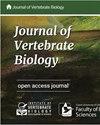Non-native gobies share predominantly immature parasites with local fish hosts
IF 1.5
4区 生物学
Q2 ZOOLOGY
引用次数: 9
Abstract
Abstract. Non-native species are known to escape their parasites following introduction into a new range, but they also often acquire local parasites as a function of time since establishment. We compared the parasite faunas of five non-native Ponto-Caspian gobies (Gobiidae) and local fish species (Perca fluviatilis, Gymnocephalus cernua, Gobio gobio) in three European river systems; the Rivers Rhine, Vistula and Morava, where Ponto-Caspian gobies were introduced 4-13 years prior to the study. Overall parasite species richness was considerably lower in non-native gobies compared to local fish species, and the same result was found at the component and infra-community levels. Both parasite abundance and diversity greatly varied among the regions, with the highest values found in the River Vistula (Wloclawski Reservoir), compared to a relatively impoverished parasite fauna in the River Morava (Danube basin). While only half of parasite species found in local hosts were acquired by non-native gobies, most of the parasites found in gobies were shared with local fish species related either phylogenetically (percids) or ecologically (benthic gudgeon), including the co-introduced monogenean Gyrodactylus proterorhini. As a result, similarity in parasite communities strongly reflected regional affiliation, while phylogenetic distances between fish host species did not play a significant role in parasite community composition. In accordance with other studies, all parasites acquired by gobies in their new range were generalists, all of them infecting fish at the larval/subadult stage, indicating the possible importance of gobies in the life cycle of euryxenous parasites. The absence of adult generalists, particularly ectoparasites with low host specificity, in non-native fish may reflect their generally low abundance in the environment, while an absence of adult endoparasitic generalists was probably related to other factors.非本地的虾虎鱼主要与本地的鱼宿主共享未成熟的寄生虫
摘要众所周知,非本地物种在被引入一个新的范围后会逃脱寄生虫,但自建立以来,它们也经常会随着时间的推移而感染本地寄生虫。我们比较了欧洲三个水系中五种非本地蓬托-里海虾虎鱼(虾虎科)和当地鱼类(河鲈鱼、裸头虾虎鱼、虾虎鱼)的寄生虫区系;研究前4-13年,在莱茵河、维斯瓦河和莫拉瓦河引入了蓬托里海虾虎鱼。与当地鱼类相比,非本地虾虎鱼的总体寄生虫物种丰富度要低得多,在成分和基础群落层面也发现了同样的结果。各地区的寄生虫丰度和多样性差异很大,维斯瓦河(Wloclawski水库)的寄生虫数量和多样性最高,而莫拉瓦河(多瑙河流域)的寄生虫动物群相对贫乏。虽然在当地宿主中发现的寄生虫物种中只有一半是由非本地虾虎鱼获得的,但在虾虎鱼中发现的大多数寄生虫都与系统发育(percids)或生态(底栖gudgeon)相关的当地鱼类共享,包括共同引入的单基因Gyrodactylus proterorhini。因此,寄生虫群落的相似性强烈反映了区域隶属关系,而鱼类宿主物种之间的系统发育距离在寄生虫群落组成中没有发挥重要作用。根据其他研究,虾虎鱼在其新范围内获得的所有寄生虫都是多面手,所有这些寄生虫都在幼虫/亚成年期感染鱼类,这表明虾虎鱼可能在广粘性寄生虫的生命周期中具有重要意义。非本地鱼类中缺乏成年多面手,特别是宿主特异性低的体外寄生虫,可能反映了它们在环境中的丰度普遍较低,而缺乏成年内寄生虫多面手可能与其他因素有关。
本文章由计算机程序翻译,如有差异,请以英文原文为准。
求助全文
约1分钟内获得全文
求助全文

 求助内容:
求助内容: 应助结果提醒方式:
应助结果提醒方式:


